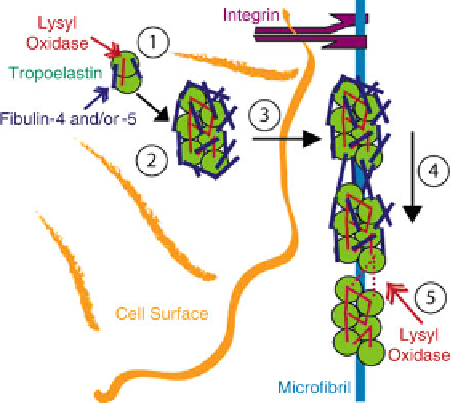Biology Reference
In-Depth Information
Fig. 9.1 Hypothetical model of elastic fiber assembly. (1) Tropoelastin is secreted by the cell and
transported to the assembly site on the cell where it is organized into small aggregates that are
cross linked by LOX. Cell surface-binding proteins may serve to facilitate movement of the
aggregates. Interactions with fibulin-4 and/or -5 facilitate cross-linking and formation of proper-
sized aggregates. (2) Aggregates on the cell surface continue to assemble with new tropoelastin.
(3) Aggregates are transferred to extracellular microfibrils that are held in proximity to the cells by
integrins. Fibulin-4 and/or -5 may assist in the transfer and cross-linking of the aggregates to the
microfibril. (4) Elastin aggregates on the microfibril continue to form larger structures. (5) Elastin
aggregates are further cross-linked by LOX/LOXL to form the elastic fiber (Reproduced with
permission from Wagenseil and Mecham,
2007
.)
microfibril, which are composed of fibrillin-1 and/or -2 and possibly other asso-
ciated proteins such as the MAGPs. Once in close contact, fibulin-4 and -5 within
the aggregates can bind with the fibrillin-1 of the microfibril thereby transferring the
elastin aggregate onto the microfibril. The aggregates form larger and larger
structures and are further cross-linked by LOX and/or LOXL. Of note, the authors
hypothesize that the fact that many of these proteins are not detected by antibodies
in the mature elastic fiber may represent that they are coated with elastin during
fiber assembly, that they are displaced to the outside of the fiber, or that they are
degraded during the process (Wagenseil and Mecham
2007
).
9.2.6.5 Structural Contributions
The ideal elastic fiber uses the relaxation phase to fully recover the energy invested
into it during extension. This is essential since there is fairly low elastin turnover
and therefore the fibers from birth are exposed to the same stretch-relaxation
cycles. As such, by the time individuals are entering their seventh decade of life,
their aorta has been subject to approximately a billion stretch-relaxation cycles
(Urry and Parker
2002
).

